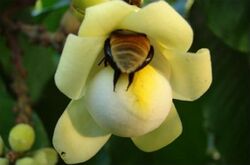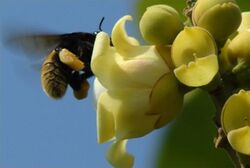Biology:Eulaema mocsaryi
| Eulaema mocsaryi | |
|---|---|

| |
| Male Eulaema mocsaryi in Brazil nut flower | |
| Scientific classification | |
| Domain: | Eukaryota |
| Kingdom: | Animalia |
| Phylum: | Arthropoda |
| Class: | Insecta |
| Order: | Hymenoptera |
| Family: | Apidae |
| Genus: | Eulaema |
| Species: | E. mocsaryi
|
| Binomial name | |
| Eulaema mocsaryi Friese, 1899
| |
| Synonyms[1] | |
| |
Eulaema mocsaryi is a species of large-bodied bee in the tribe Euglossini, the orchid bees. It was named in honour of the Hungarian entomologist Alexander Mocsáry, curator of the Hungarian Natural History Museum.[1] It is native to forests in parts of tropical South America.
Description
The head of Eulaema mocsaryi has a central raised ridge and both the head and thorax are clad in short velvety black hairs. The colour of the head and thorax is mainly black. The legs are black and hairy and the tibial joints of the hind legs are wide and compressed. The dark-coloured abdomen is densely covered with short tawny-yellowish hairs, becoming paler towards the tip of the abdomen.[1]
Distribution
Eulaema mocsaryi is native to the forests of Colombia, Surinam and the Amazon basin in Brazil.[1]
Ecology

Eulaema mocsaryi has been seen visiting the flowers of Solanum toxicarium and Polygala spectabilis. The male has a mutualistic relationship with the orchid Cattleya eldorado, from which it obtains fragrances which it stores in cavities in its hind legs.[2]
Research was undertaken to identify which insects pollinated the flowers of the Brazil nut tree (Bertholletia excelsa). It was found that a number of species of bee did so and that Eulaema mocsaryi was one of the most frequent visitors and played an important role in pollination, visiting several flowers on each tree and moving from tree to tree. The researchers concluded that for successful pollination to take place in commercial Brazil nut plantations, the plantations needed to be surrounded by intact primary forest with its epiphytic orchid population to supply the other needs of these orchid bees.[3]
References
- ↑ 1.0 1.1 1.2 1.3 Moure, J. F. (2000). "The species of the genus Eulaema Lepeletier, 1841 (Hymenoptera, Apidae, Euglossinae)" (in Portuguese). Acta Biológica Paranaense 29 (1–4): 1–70. doi:10.5380/abpr.v29i0.582. http://ojs.c3sl.ufpr.br/ojs/index.php/acta/article/download/582/474. Retrieved 2014-03-15.
- ↑ Nelis A., Van Der Cingel (2001). An Atlas of Orchid Pollination: Orchids of South and Central America. CRC Press. p. 119. ISBN 9789054104865. https://books.google.com/books?id=kUGL1TAaEtEC&dq=Eulaema+mocsaryi&pg=PA119.
- ↑ Cavalcante, M. C.; Oliveira, F. F.; Maués, M. M.; Freitas, B. M. (2012). "Pollination Requirements and the Foraging Behavior of Potential Pollinators of Cultivated Brazil Nut (Bertholletia excelsa Bonpl.) Trees in Central Amazon Rainforest". Psyche: A Journal of Entomology 2012: 1–9. doi:10.1155/2012/978019.
Wikidata ☰ Q3949888 entry
 |

